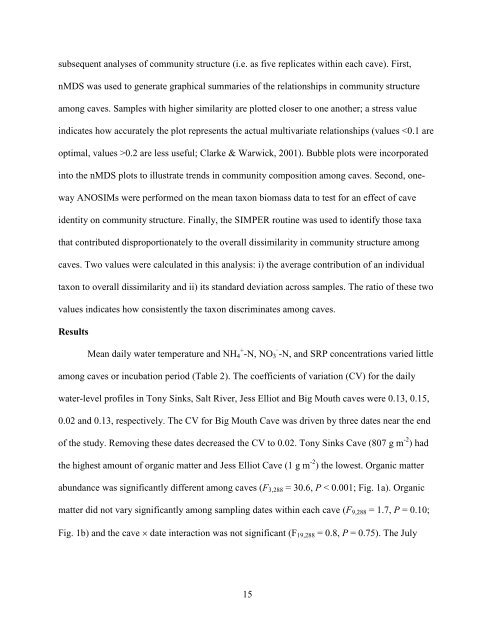TITLE PAGE - acumen - The University of Alabama
TITLE PAGE - acumen - The University of Alabama
TITLE PAGE - acumen - The University of Alabama
You also want an ePaper? Increase the reach of your titles
YUMPU automatically turns print PDFs into web optimized ePapers that Google loves.
subsequent analyses <strong>of</strong> community structure (i.e. as five replicates within each cave). First,<br />
nMDS was used to generate graphical summaries <strong>of</strong> the relationships in community structure<br />
among caves. Samples with higher similarity are plotted closer to one another; a stress value<br />
indicates how accurately the plot represents the actual multivariate relationships (values 0.2 are less useful; Clarke & Warwick, 2001). Bubble plots were incorporated<br />
into the nMDS plots to illustrate trends in community composition among caves. Second, oneway<br />
ANOSIMs were performed on the mean taxon biomass data to test for an effect <strong>of</strong> cave<br />
identity on community structure. Finally, the SIMPER routine was used to identify those taxa<br />
that contributed disproportionately to the overall dissimilarity in community structure among<br />
caves. Two values were calculated in this analysis: i) the average contribution <strong>of</strong> an individual<br />
taxon to overall dissimilarity and ii) its standard deviation across samples. <strong>The</strong> ratio <strong>of</strong> these two<br />
values indicates how consistently the taxon discriminates among caves.<br />
Results<br />
Mean daily water temperature and NH + 4 -N, NO 3¯-N, and SRP concentrations varied little<br />
among caves or incubation period (Table 2). <strong>The</strong> coefficients <strong>of</strong> variation (CV) for the daily<br />
water-level pr<strong>of</strong>iles in Tony Sinks, Salt River, Jess Elliot and Big Mouth caves were 0.13, 0.15,<br />
0.02 and 0.13, respectively. <strong>The</strong> CV for Big Mouth Cave was driven by three dates near the end<br />
<strong>of</strong> the study. Removing these dates decreased the CV to 0.02. Tony Sinks Cave (807 g m -2 ) had<br />
the highest amount <strong>of</strong> organic matter and Jess Elliot Cave (1 g m -2 ) the lowest. Organic matter<br />
abundance was significantly different among caves (F 3,288 = 30.6, P < 0.001; Fig. 1a). Organic<br />
matter did not vary significantly among sampling dates within each cave (F 9,288 = 1.7, P = 0.10;<br />
Fig. 1b) and the cave × date interaction was not significant (F 19,288 = 0.8, P = 0.75). <strong>The</strong> July<br />
15
















